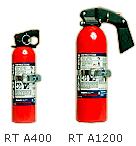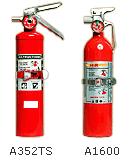Before you consider the least expensive dry chemical fire extinguisher for your airplane, try one out by using it to put out a fire in your barbecue grill. You won't like what it does to your charcoal cooker. The dry powder fire extinguishers put out fires by smothering them in a thick cloud of white powder that covers everything. And you surely don't want to breathe that powder. If you were trapped in a burning airplane cockpit and if you used a dry chemical extinguisher to douse the flames, you would not be able to breathe in the dust cloud. And the dry powder is extremely hard to clean up afterward, even with a vacuum cleaner. The dry chemical is corrosive and would likely do extensive damage to your interior and to your airplane instrument panel.
HALON 1211 AND 1301 EXTINGUISHERS
The only fire extinguishers that won't choke you and won't damage your aircraft are the liquid Halon extinguishers. They are more expensive than dry chemicals, costing about $100 for a 2-1/2 pound dry chemical extinguisher, but the results are worth the difference in price. Halon works to extinguish fires by using a liquid that turns to gas when it is sprayed into a fire. The gas displaces oxygen to rob the fire of oxygen and cause it to go out. If you spray Halon into the air, it disappears almost as soon as it is sprayed, but is highly effective in closed areas.
OZONE LAYER DEPLETION
For a number of years, Halon was in danger of being outlawed because it could contribute to depleting the Earth's ozone layer. But, in fact, when it is used to extinguish fires, it is neutralized by the fire as it extinguishes it. The approved way to dispose of unwanted Halon is to release the gas into a furnace which neutralizes the chemistry of the Halon. Also, if there is no fire, there will be no need to spray the Halon. As the Environmental Protection Agency now concedes, Halon is a highly effective agent for fire fighting in closed passenger carrying areas. Even if it is not needed for fire extinguishing, it is the best fire insurance policy you can buy.
BUILT-IN HALON SYSTEMS
One supplier of race car fire extinguishing systems that include on-board driver/pilot operated systems, also sells the same systems for airplanes. In these installations, the Halon bottle is semi-permanently mounted in a convenient place in the race car or airplane. Halon is dispensed through 1/4" diameter aluminum tubing to selected places in the cockpit. A pull-cable or even a solenoid switch operated by the driver/pilot activates the Halon when needed.
EXPLOSION SUPPRESSING FUEL TANKS
Builders
of experimental aircraft should also investigate the possibility
of incorporating explosion suppressing foam in the fuel tanks of
their aircraft. Race car fuel cells could be fitted to aircraft in
many instances and are actually less expensive than welded
aluminum tanks which offer no fire or explosion protection.
Explosion suppressing foam for fuel tanks is made to be installed
in the entire tank, save for cutouts for fuel quality senders,
filler neck openings and outlet areas. This foam is about 2% to 3%
density, meaning that in a 10 gallon fuel tank, it displaces .2 to
.3 of a gallon. In appearance, it resembles a very open weave
Scotchbrite TM pad. The life expectancy of the reticulated
polyurethane foam is 50 years. The cost of the foam is about $1
per gallon of fuel tank size. It can be retrofitted to existing
fuel tanks if the tank has a hand access opening. Talk to race car
mechanics if they are considering this protection for your
aircraft fuel system.
Aviation
fire extinguishers are sold through aviation distributors world
wide.
or email us for a distributor in your area

